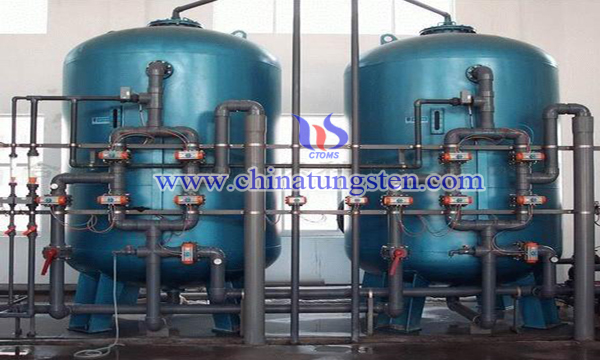Energy Reducing Strategy of Ion Exchange Method
- Details
- Category: Tungsten Information
- Published on Monday, 05 February 2018 16:05
Tungsten is an important strategic reserve metal, which is one of the few superior mineral resources in our country. Over the years, China's tungsten smelting technology has become more and more mature. The ion exchange method of tungsten smelting is a smelting technology that is firstly developed by China's science and technology workers. The promotion of ion exchange process in tungsten smelting has made the overall level of China's tungsten smelting increase substantially and product quality rise to a higher level.

The basic principle of ion exchange method is using the exchange reaction of strongly basic anion exchange resin and alkaline sodium tungstate solution to absorb tungsten, most of the impurities such as P, As, Si, Mo, Sn etc. left in the post-solution. And then a mixed solution of NH4Cl and NH3 H2O was used as desorption to desorb tungsten on the resin to obtain a relatively pure (NH4)2WO4 solution. Ion exchange technology, easy operation and prominent effect, has gotten promoted in the country since it was introduced.
The ion exchange technology of tungsten smelting has brought significant technological progress to China's tungsten smelting, but it also has some shortcomings. The main problems are the large amount of water used and the pollution of waste water. Therefore, Chinese scholars have been constantly improving the ion exchange technology in practice.
Recently, Huang Zehui and others proposed a method for preparing ammonium paratungstate by using the ion exchange method. The method can effectively improve the tungsten concentration in the liquid treated in the ion exchange step and reduce the wastewater brought by the ion exchange process.
The proposed method for preparing ammonium paratungstate by ion exchange method comprises:
(1) Obtain alkaline sodium tungstate feed liquid through alkali treatment of tungsten concentrates.
(2) Add acidic material into alkaline sodium tungstate feed liquid and heat them, and then through neutralizing treatment to obtain sodium tungstate feed liquid.
(3) Dilute the sodium tungstate feed liquid to obtain pre-solution which has a pH of 8 to 9; the concentration of tungsten trioxide is from 30 to 100 g/L, with the preference of 50 to 60 g/L, which can significantly reduce the production of wastewater during the production process of ammonium paratungstate.
(4) A weakly basic anion exchange resin (312 resin or 640 resin) is used to adsorb the pre-solution and then obtaining a weakly basic anion exchange resin with pre-solution.
(5)Use desorption agent to desorb the weakly basic anion exchange resin with the pre-treatment solution to obtain a desorption solution which is a mixed solution of ammonium chloride and ammonia or concentrated aqueous ammonia.
(6)The desorption solution is subjected to impurity treatment; ammonium sulfide (the concentration of sulfide ions in the ammonium sulfide is 80 g/L) is subjected to sulphur treatment to obtain the impurity-removal-post-solution.
(7) Through evaporative crystallization process of impurity removal liquid to obtain ammonium paratungstate.
The advantage of the improved plan lies in that the method for preparing ammonium paratungstate by the ion exchange method adopts a weakly basic anion exchange resin such as 312 resin or 640 resin, with the pH of the sodium tungstate material liquid only need to reach 8 to 9. Meanwhile, using tungsten oxide waste, ammonium paratungstate waste, tungstic acid, tungsten carbide roasting waste, metatungstate, heteropoly tungstate, tungstocobalt heteropoly salts and other acidic substances to neutralize, which not only avoids consuming a large amount of acid and reduces the cost, but also can recycle the above acidic substances containing tungsten and improve resource utilization.
- Tungsten Manufacturer & Supplier, Chinatungsten Online: www.chinatungsten.com
- Tungsten News & Prices of China Tungsten Industry Association: www.ctia.com.cn
- Molybdenum News & Price: news.molybdenum.com.cn
- Tel.: 86 592 5129696; Fax: 86 592 5129797; Email: sales@chinatungsten.com



 sales@chinatungsten.com
sales@chinatungsten.com